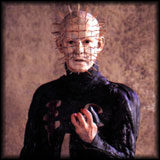
  Pinhead originated as Captain Elliot Spenser (c. 1880-1921), an explorer
and a British Army veteran who served in World War I. His transformation
into Pinhead, the angel of suffering and leader of the Cenobites, came
about through his opening of the demonic Lament Configuration and he was
subsequently possessed by the Cenobite spirit Xipe Totec.
Pinhead originated as Captain Elliot Spenser (c. 1880-1921), an explorer
and a British Army veteran who served in World War I. His transformation
into Pinhead, the angel of suffering and leader of the Cenobites, came
about through his opening of the demonic Lament Configuration and he was
subsequently possessed by the Cenobite spirit Xipe Totec.
The character of Pinhead presented somewhat of a departure from the horror movie villains which preceded him. One aspect of this uniqueness is his lack of muteness; he can and does speak (unlike Jason Voorhees and Michael Myers). However, he speaks very little and is not at all comical or glib (unlike Freddy Krueger or Chucky). When he does indulge in humor it is notably dry. Another difference between Pinhead and other film killers, supernatural and otherwise, is his need to have been purposely summoned, as the Lament Configuration must be opened for the Cenobites to enter the world. Pinhead kills not indiscriminately, nor for vengeance; he kills because he was conjured from Hell by the opener of the puzzle box. The act of opening the Lament Configuration is not in and of itself reason to be killed: in Hellbound: Hellraiser II, Pinhead stops the Cenobites from killing Tiffany, a mentally ill girl who opened the box only after being manipulated by the evil Dr. Channard. “…it is not hands that call us, it is desire…” Pinhead's other difference from typical horror killers is his ability to be reasoned and bargained with. In both Hellraiser and Hellraiser: Hellseeker, the character Kirsty bargains with Pinhead to offer him more "souls" in exchange for her own (in particular her human adversaries), thus ending with him sparing her life.  Pinhead does not kill quickly; he and the Cenobites are well-versed in
torture. Death does not end the suffering of his victims, either, as the
victims are brought to Hell/the Labyrinth, where (in Pinhead's words),
"We have an eternity to know your flesh."
Pinhead does not kill quickly; he and the Cenobites are well-versed in
torture. Death does not end the suffering of his victims, either, as the
victims are brought to Hell/the Labyrinth, where (in Pinhead's words),
"We have an eternity to know your flesh."
Since the first film, Pinhead's role has varied with each installment. In the original Hellraiser, Pinhead was simply named "Lead Cenobite" and was part of a collective group whose purpose was to give pleasure and pain to those who opened the Box. They were not 'evil' as such, simply a force that existed to explore experience. The second film followed this but the third film radically changed the original concept, making Pinhead and the Cenobites into typical Hollywood monsters. In the fourth film he is presented as a demon of Hell who wants to take over Earth and though by the fifth he is simply out to torture those who solve the box. The seventh film goes back to the originals with the Cenobites being responsible for pleasure and pain though still borders on the demonic portrayal of the middle installments. With this in mind, most Hellraiser fans only consider the first two films as the true version of Pinhead and the Cenobites.
Copyright ©
Wikipedia / TheFleshFarm.com
|











